Migrating data from Foxpro to SQL Azure
This guide will show you how to easily migrate data from Foxpro to SQL Azure through a few simple steps with ESF Database Migration Toolkit, simplifying the complex migration processes and saving you valuable time.
Foxpro vs. SQL Azure:
- FoxPro is a text-based, procedural programming language and database management system developed by Microsoft. It was widely used in the 1980s and 1990s for building database applications, known for its high performance in handling large databases. FoxPro evolved from FoxBASE and was later integrated into Microsoft's Visual FoxPro, which added object-oriented programming capabilities and a graphical user interface. Despite being discontinued in 2007, FoxPro remains in use for maintaining legacy systems and applications.
- Microsoft SQL Azure, also known as Azure SQL Database, is a fully managed relational database service provided by Microsoft. It offers scalable and high-performance SQL database capabilities in the cloud, with built-in high availability, automated backups, and robust security features. Designed to handle both small and large-scale applications, Azure SQL Database simplifies database management tasks, allowing developers to focus on building applications without worrying about underlying infrastructure. It supports various deployment options, including single databases, elastic pools, and managed instances, catering to diverse business needs.
Prerequisite:
Software Required:
DMToolkit_x64.zip
(63.5 MiB)64-bit Windows application for ESF Database Migration Toolkit 12.2.07 (2025-07-01).
(md5: 0750355677f7108916a6c1f2bc0d4d87)DMToolkit_win32.zip
(58.9 MiB)32-bit Windows application for ESF Database Migration Toolkit 12.2.07 (2025-07-01).
(md5: a9ba6351d787ff958b4ff2d9ca888576)System Supported:
- Windows 7 or higher.
- Foxpro 2.6 or higher.
- SQL Azure.
Step by Step Wizard:
-
In "Choose a Data Source" dialog, choose "Visual Foxpro Database (*.dbc) " or "FoxPro/dBase Free Table (*.dbf)" ;
- Click "..." to browse for the Visual FoxPro Database file(.dbc) or select the folder that contains the FoxPro/dBase free tables.
- Click "Next" to proceed to the next step.
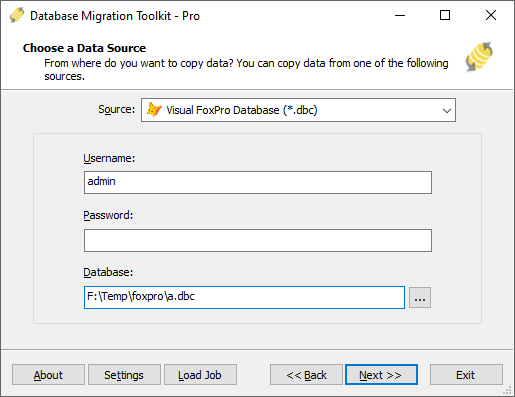
Visual Foxpro Database (*.dbc)
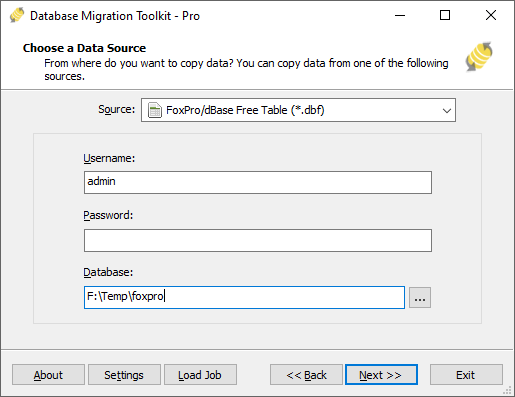
Foxpro Free Table(*.dbf)
-
In "Choose a Data Destination" dialog, choose "SQL Azure";
- To access Azure services, ensure that you have allowed access in the "Firewalls and virtual networks" page of the Azure server, and added your client IP to the rules list.
- Enter the SQL Azure server name, such as "esf.database.windows.net".
- Enter the server port, such as 1433.
- Enter the username and password for authentication.
- Click the "Refresh Database" button to display a list of all databases, then choose an existing database.
- Click the "Refresh Schema" button to display a list of all schemas, then choose an existing schema (default is "dbo").
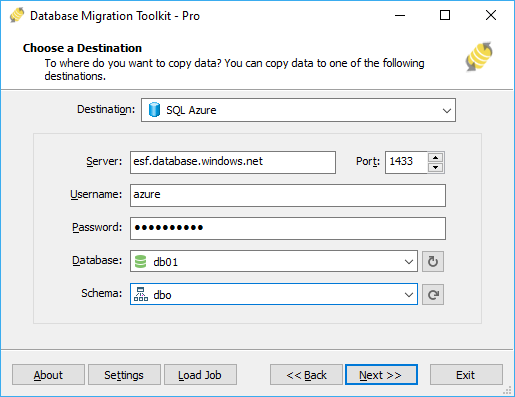
-
In "Select source Tables(s) & View(s)" dialog;
- Select the tables or views you want to migrate.
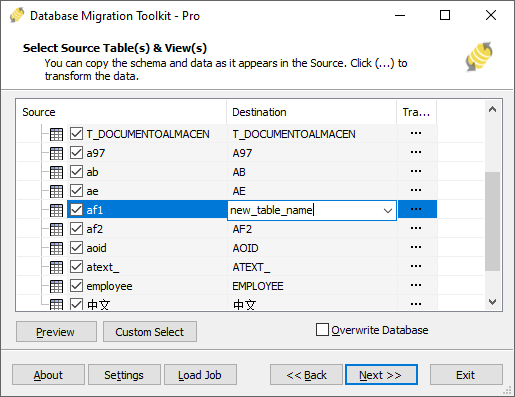
- You can access the table options or adjust the table structure by clicking the "..." button.

- In the "Field Mapping" option, you can customize the destination table's fields, such as field name, data type, default value, comment, and more. You also have the option to choose the data transfer method, including Overwrite Table, Empty Data, Append Data, or Skip Table, or even filter the data before transferring it.
- Select the tables or views you want to migrate.
-
In "Execution" Dialog;
- You can start the migration process by clicking "Submit". The toolkit will efficiently and seamlessly migrate your data from Foxpro to SQL Azure without the need for manual intervention.
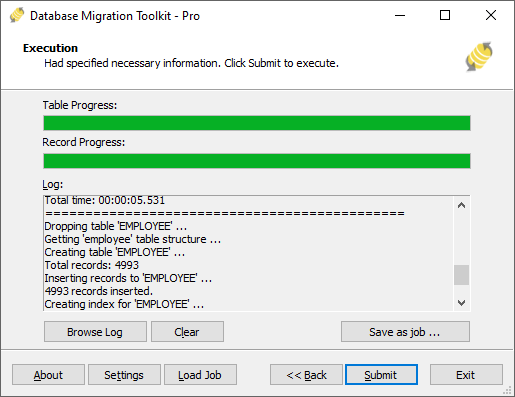
- To keep track of the migration process, you can access the full migration log by clicking "Browse Log". This will provide you with a comprehensive view of the entire migration, including any potential issues and their resolutions.
- To save time in the future, you can save the migration settings as a job file by clicking "Save as job". This allows you to quickly reload the migration job at a later time or run the migration job using the command-prompt by typing "dmtc.exe --help". The command-prompt provides you with a full list of parameters to customize the migration process to your specific needs.
- You can start the migration process by clicking "Submit". The toolkit will efficiently and seamlessly migrate your data from Foxpro to SQL Azure without the need for manual intervention.
-
Finished!
Upon completion, the toolkit will generate a comprehensive migration report, providing you with all the information you need to verify the accuracy and completeness of the migration process. So, you can sit back and relax while the program carries out the task efficiently. Should you have any inquiries or recommendations, don't hesitate to reach out to us. We're always happy to help.